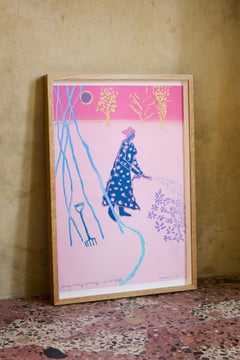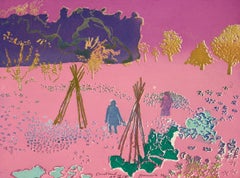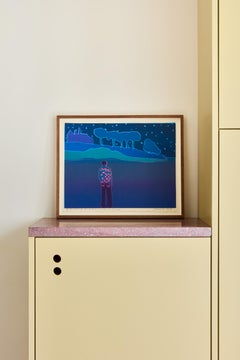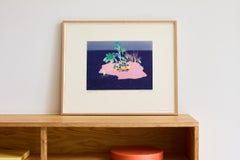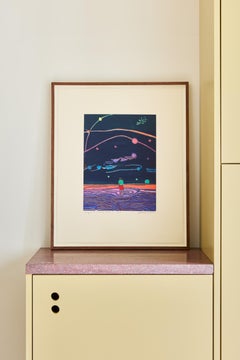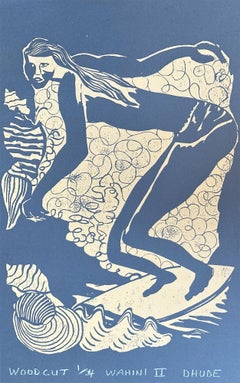RAW Editions Landscape Prints
to
7
7
1
1
1
Overall Width
to
Overall Height
to
15
1
11
2
1
1
1
4
13
3
1
10
7
9
8
3
3
2
2
1
1
1
1
1
1
1
1
1
1
1
1
1
1
7
7
6
1
1
6
6
17
Early Morning Watering -- Etching, Aquatint, Print, Art by Tom Hammick
By Tom Hammick
Located in London, GB
Early Morning Watering, 2022
Tom Hammick
Etching with aquatint and chine colle in colours, on wove
Signed, titled, dated and numbered
Inscribed 'EV' (edition variable) and ‘A.P.I/VI...
Category
2010s Contemporary Landscape Prints
Materials
Etching, Aquatint
Cloudland -- Etching, Aquatint, Print, Art by Tom Hammick
By Tom Hammick
Located in London, GB
Cloudland, 2022
Tom Hammick
Etching with aquatint and sugar lift in colours
On Somerset Velvet soft white wove
Signed, titled, dated, numbered and inscribed 'E.V.' (edition variable...
Category
2010s Contemporary Landscape Prints
Materials
Aquatint, Etching
Dark Woods -- Etching, Print, Art by Tom Hammick
By Tom Hammick
Located in London, GB
Dark Woods, 2019
Tom Hammick
Etching in colours, on wove
Signed, titled, dated, numbered and inscribed 'E.V.' (edition variable)
From the edition of 25
Plate: 25 × 33 cm (9.8 × 13 i...
Category
2010s Contemporary Landscape Prints
Materials
Etching, Aquatint
Dusky Island -- Etching, Aquatint, Print, Art by Tom Hammick
By Tom Hammick
Located in London, GB
Dusky Island, 2019
Tom Hammick
Etching with aquatint in colours, on wove
Signed, titled, dated, numbered and inscribed 'E.V.' (edition variable)
From the edition of 30
Plate: 25 × 3...
Category
2010s Contemporary Landscape Prints
Materials
Etching, Aquatint
In the Bosom of the Darkest Woods --Reduction Woodcut, Print by Tom Hammick
By Tom Hammick
Located in London, GB
In the Bosom of the Darkest Woods, 2019
Tom Hammick
Reduction woodcut in colours, on Japanese paper
Signed, titled, dated, numbered and inscribed 'E.V.' (edition variable)
From the ...
Category
2010s Contemporary Landscape Prints
Materials
Woodcut
The Night Is a Starry Dome -- Etching, Aquatint, Print, Art by Tom Hammick
By Tom Hammick
Located in London, GB
The Night Is a Starry Dome, 2019
Tom Hammick
Etching with aquatint in colours, on wove
Signed, titled, dated, numbered and inscribed 'E.V.' (edition variable)
From the edition of 30...
Category
2010s Contemporary Landscape Prints
Materials
Etching, Aquatint
In the High Mountains -- Reduction Woodcut, Print, Art by Tom Hammick
By Tom Hammick
Located in London, GB
In the High Mountains, 2019
Tom Hammick
Reduction woodcut in colours, on Japanese paper
Signed, titled, dated, numbered and inscribed 'EV' (edition variable)
From the edition of 20
...
Category
2010s Contemporary Landscape Prints
Materials
Woodcut
Crossing -- Reduction Woodcut, Print, Art by Tom Hammick
By Tom Hammick
Located in London, GB
Crossing, 2025
Tom Hammick
Reduction woodcut in colours
On Saunders Waterford wove
Signed, titled, dated, numbered and inscribed 'E.V.' (edition variable)
From the edition of 25
She...
Category
2010s Contemporary Landscape Prints
Materials
Woodcut
Mani Sunset -- Reduction Woodcut, Print, Human Figure, Art by Tom Hammick
By Tom Hammick
Located in London, GB
Mani Sunset, 2025
Tom Hammick
Reduction woodcut in colours
On Saunders Waterford wove
Signed, titled, dated, numbered and inscribed 'E.V.' (edition variable)
From the edition of 25
...
Category
2010s Contemporary Landscape Prints
Materials
Woodcut
Stag in the Foothills -- Reduction Woodcut, Print, Animal, Art by Tom Hammick
By Tom Hammick
Located in London, GB
Stag in the Foothills, 2025
Tom Hammick
Reduction woodcut in colours
On Saunders Waterford wove
Signed, titled, dated, numbered and inscribed 'E.V.' (edition variable)
From the edit...
Category
2010s Contemporary Landscape Prints
Materials
Woodcut
Living Room and Terrace, July 1986 -- Homemade Print by David Hockney
By David Hockney
Located in London, GB
David Hockney
Living Room and Terrace, July 1986
Homemade print in colours executed on an office colour copy machine, On two sheets of Arches rag paper
Signed, dated and numbered 36/...
Category
1980s Landscape Prints
Materials
Other Medium
Badlands -- Reduction Woodcut, Print, Animal, Art by Tom Hammick
By Tom Hammick
Located in London, GB
Stag in the Foothills, 2025
Tom Hammick
Reduction woodcut in colours
On Saunders Waterford wove
Signed, titled, dated, numbered and inscribed 'E.V.' (edition variable)
From the edit...
Category
2010s Contemporary Landscape Prints
Materials
Woodcut
England as Seen from Lockdown in Islington -- Digital Print by Grayson Perry
By Grayson Perry
Located in London, GB
England as Seen from Lockdown in Islington, 2021
Grayson Perry
Pigment print on 300gsm cotton panama
Signed on the accompanying label
From the edition of 150
Co-published by Victori...
Category
2010s Contemporary Landscape Prints
Materials
Digital
Untitled (Cityscape) -- Print, Lithograph, Landscape, Pop Art by Julian OPie
By Julian Opie
Located in London, GB
Untitled (Cityscape), 1996
Julian Opie
Lithograph in colours, on Somerset White Satin wove
Signed in pencil
A printer’s proof aside from the numbered edition of 100
Printed by Sky Editions, London
Published by Monica de Cardenas...
Category
1990s Pop Art Landscape Prints
Materials
Lithograph
Deconstructing Seurat (turquoise green) -- Screen Print by Michael Craig-Martin
By Michael Craig-Martin
Located in London, GB
Deconstructing Seurat (turquoise green), 2004
Michael Craig-Martin
A pair of screenprints in colours, on wove
Each signed, dated and numbered verso from the edition of 40
Published ...
Category
Early 2000s Contemporary Landscape Prints
Materials
Screen
How Many Miles to Babylon -- Print, Etching, Nursery Rhymes by Paula Rego
By Paula Rego
Located in London, GB
How Many Miles to Babylon, 1989
Paula Rego
Etching with aquatint, on velin Arches
Signed and inscribed ‘A/P’, apart from the edition of 50
From Nursery Rhym...
Category
1980s Contemporary Figurative Prints
Materials
Aquatint, Etching
See-saw, Margery Daw -- Print, Etching, Nursery Rhymes by Paula Rego
By Paula Rego
Located in London, GB
See-saw, Margery Daw, 1994
Paula Rego
Etching with aquatint and hand-colouring, on velin Arches
Signed and numbered from the edition of 50
From Nursery Rhymes
Printed by Culford P...
Category
1980s Contemporary Figurative Prints
Materials
Etching, Aquatint
Related Items
The House of Naiads - Woodcut Print by G. Verna - 1946
By Claudio Verna
Located in Roma, IT
Image dimension 36.5 x 18 cm.
Hand Signed. Edition of 100 pieces.
Category
1940s Contemporary Landscape Prints
Materials
Woodcut
$310
H 19.69 in W 13.78 in D 0.04 in
Wahini #2 - Surfing Art - Figurative - Woodcut Print By Marc Zimmerman
By Marc Zimmerman
Located in Carmel, CA
Wahini #2 - Surfing Art - Figurative - Woodcut Print By Marc Zimmerman
Limited Edition 01/04
This masterwork is exhibited in the Zimmerman Gallery, Carmel CA.
Immerse yourself in ...
Category
2010s Contemporary Figurative Prints
Materials
Woodcut
"Casa Marquez" Original Woodblock Print, Signed and Numbered 93/100
By Carol Summers
Located in Soquel, CA
"Casa Marquez" Original Woodblock Print, Signed and Numbered 93/100
Boldly colored woodblock print by Carol Summers (American, 1925-2016). This piece is a closeup on a large stone building, with a landscape reflected in the windows. The building has carved ornamentation in a classical style. There is a bright red sunset in the background behind the building. The title refers to the author Gabriel García Márquez.
Signed "Carol Summers" in the lower right corner.
Numbered and titled "93/100 Casa Marquez" in the upper right corner.
Presented in a silver colored aluminum frame.
Frame size: 19.25"H x 23.25"W
Paper size: 16"H x 20"W
Carol Summers (1925-2016) has worked as an artist throughout the second half of the 20th century and into the first years of the next, outliving most of his mid-century modernist peers. Initially trained as a painter, Summers was drawn to color woodcuts around 1950 and it became his specialty thereafter. Over the years he has developed a process and style that is both innovative and readily recognizable. His art is known for it’s large scale, saturated fields of bold color, semi-abstract treatment of landscapes from around the world and a luminescent quality achieved through a printmaking process he invented.
In a career that has extended over half a century, Summers has hand-pulled approximately 245 woodcuts in editions that have typically run from 25 to 100 in number. His talent was both inherited and learned. Born in 1925 in Kingston, a small town in upstate New York, Summers was raised in nearby Woodstock with his older sister, Mary. His parents were both artists who had met in art school in St. Louis. During the Great Depression, when Carol was growing up, his father supported the family as a medical illustrator until he could return to painting. His mother was a watercolorist and also quite knowledgeable about the different kinds of papers used for various kinds of painting. Many years later, Summers would paint or print on thinly textured paper originally collected by his mother.
From 1948 to 1951, Carol Summers trained in the classical fine and studio arts at Bard College and at the Art Students League of New York. He studied painting with Steven Hirsh and printmaking with Louis Schanker. He admired the shapes and colors favored by early modernists Paul Klee (Sw: 1879-1940) and Matt Phillips (Am: b.1927- ). After graduating, Summers quit working as a part-time carpenter and cabinetmaker (which had supported his schooling and living expenses) to focus fulltime on art. That same year, an early abstract, Bridge No. 1 was selected for a Purchase Prize in a competition sponsored by the Brooklyn Museum.
In 1952, his work (Cathedral, Construction and Icarus) was shown the first time at the Museum of Modern Art in New York City in an exhibition of American woodcuts...
Category
1980s Contemporary Landscape Prints
Materials
Ink, Handmade Paper, Woodcut
$1,722 Sale Price
35% Off
H 19.25 in W 23.25 in D 1 in
"Grave of Santa Anna's Leg" Original Woodblock Print, Signed Artist's Proof
By Carol Summers
Located in Soquel, CA
"Grave of Santa Anna's Leg" Original Woodblock Print, Signed Artist's Proof
Boldly colored woodblock print by Carol Summers (American, 1925-2016). This piece is a segment of a grave, with a headstone that has a skull and cross. There are two bright green plants flanking the headstone. Below the headstone and plants, there is a large arched blue shape, with a crescent moon and stars. A red leg, bent at the knee, cuts across the blue arch.
Signed "Carol Summers" along the right edge of the blue shape.
Numbered and titled "A/P Grave of Sant Anna's Leg" along the left edge of the blue shape.
Presented in a silver colored aluminum frame.
Frame size: 32.245"H x 27.25"W
Paper size: 29.75"H x 24.5"W
Carol Summers (1925-2016) has worked as an artist throughout the second half of the 20th century and into the first years of the next, outliving most of his mid-century modernist peers. Initially trained as a painter, Summers was drawn to color woodcuts around 1950 and it became his specialty thereafter. Over the years he has developed a process and style that is both innovative and readily recognizable. His art is known for it’s large scale, saturated fields of bold color, semi-abstract treatment of landscapes from around the world and a luminescent quality achieved through a printmaking process he invented.
In a career that has extended over half a century, Summers has hand-pulled approximately 245 woodcuts in editions that have typically run from 25 to 100 in number. His talent was both inherited and learned. Born in 1925 in Kingston, a small town in upstate New York, Summers was raised in nearby Woodstock with his older sister, Mary. His parents were both artists who had met in art school in St. Louis. During the Great Depression, when Carol was growing up, his father supported the family as a medical illustrator until he could return to painting. His mother was a watercolorist and also quite knowledgeable about the different kinds of papers used for various kinds of painting. Many years later, Summers would paint or print on thinly textured paper originally collected by his mother.
From 1948 to 1951, Carol Summers trained in the classical fine and studio arts at Bard College and at the Art Students League of New York. He studied painting with Steven Hirsh and printmaking with Louis Schanker. He admired the shapes and colors favored by early modernists Paul Klee (Sw: 1879-1940) and Matt Phillips (Am: b.1927- ). After graduating, Summers quit working as a part-time carpenter and cabinetmaker (which had supported his schooling and living expenses) to focus fulltime on art. That same year, an early abstract, Bridge No. 1 was selected for a Purchase Prize in a competition sponsored by the Brooklyn Museum.
In 1952, his work (Cathedral, Construction and Icarus) was shown the first time at the Museum of Modern Art in New York City in an exhibition of American woodcuts...
Category
1980s Contemporary Landscape Prints
Materials
Ink, Handmade Paper, Woodcut
$1,722 Sale Price
35% Off
H 32.25 in W 27.25 in D 1 in
La Jolla - Surfing Art - Figurative - Woodcut Print By Marc Zimmerman
By Marc Zimmerman
Located in Carmel, CA
La Jolla - Surfing Art - Figurative - Woodcut Print By Marc Zimmerman
Limited Edition 01/04
This masterwork is exhibited in the Zimmerman Gallery, Carmel CA.
Immerse yourself in t...
Category
2010s Contemporary Figurative Prints
Materials
Woodcut
Trees
By Nicolas Party
Located in London, GB
Woodcut on BFK Rives paper, produced in 2020. Edition of 100. Mint condition, unframed. Signed and numbered in pencil by Nicolas Party.
Category
2010s Contemporary Landscape Prints
Materials
Woodcut
Venetian Red
By Stephen McMillan
Located in Palm Springs, CA
The architecture of Venice reflected in the water of the canals. This is one of a series the artist completed during a residency in Venice. Signed, titled and numbered from the edtio...
Category
2010s Contemporary Landscape Prints
Materials
Etching, Aquatint
"Bajo el Volcan" Etching and Aquatint on Archival Paper, Limited Edition X/XXII
Located in Soquel, CA
"Bajo el Volcan" Etching and Aquatint on Archival Paper, Limited Edition X/XXII
Dramatic etching by Jorge Martínez García (Chilean, b. 1963). A mountain range rises into a cloudy sk...
Category
2010s Contemporary Landscape Prints
Materials
Ink, Archival Paper, Etching, Aquatint
$2,600 Sale Price
20% Off
H 32 in W 39 in D 1 in
Leaves, Twigs and Trees Triptych - Figurative Mixed Med Print, small edition 2/X
By Andrzej Juchniewicz
Located in Salzburg, AT
The graphic is already framed.
About Andrzej Juchniewicz - 1967–1972 Secondary School of Fine Arts in Gdynia-Orłowo. 1978–1983 studies at the Acad...
Category
1990s Contemporary Landscape Prints
Materials
Paper, Mixed Media, Etching, Aquatint
$896
H 21.66 in W 10.63 in D 0.4 in
The Domes - Lithograph by Felice Ludovisi - 1968
Located in Roma, IT
The Domes is a modern artwork realized by Felice Ludovisi in 1968.
China and penmarker drawing on paper.
Hand signed and dated on the lower margin.
...
Category
1980s Contemporary Figurative Prints
Materials
Paper, Aquatint
$1,076
H 19.69 in W 27.56 in D 0.04 in
Divide black and white soft ground etching and aquatint by April Gornik
By April Gornik
Located in Boca Raton, FL
"Divide" black and white soft ground etching and aquatint by April Gornik. Edition 23 of 30. Image size: 33 1/2 x 31 1/2 inches. Published by The S...
Category
1990s Contemporary Landscape Prints
Materials
Etching, Aquatint
$3,000
H 34 in W 41.75 in
Clarity 4
Located in Palm Springs, CA
Signed, titled and numbered from the edition of 20.
Daniel Beugniot, who signs his prints Dul, was born in Bordeaux in 1954 and died in April 2010. He spent many years teaching etch...
Category
1990s Contemporary Landscape Prints
Materials
Etching, Aquatint
